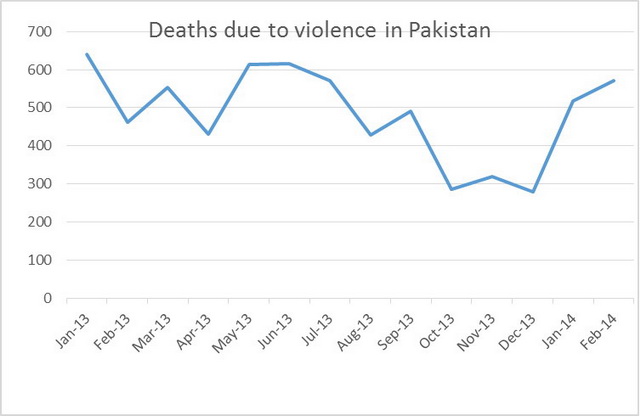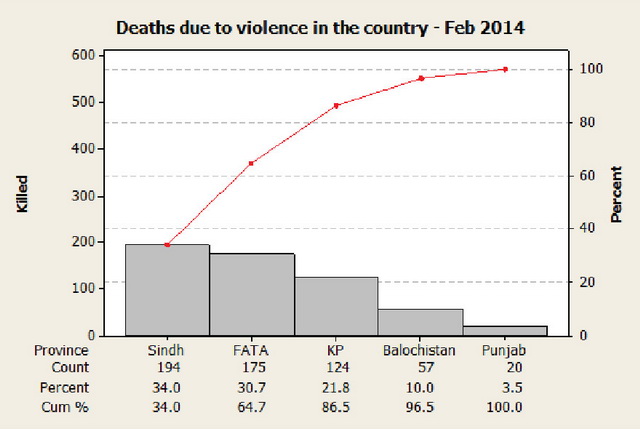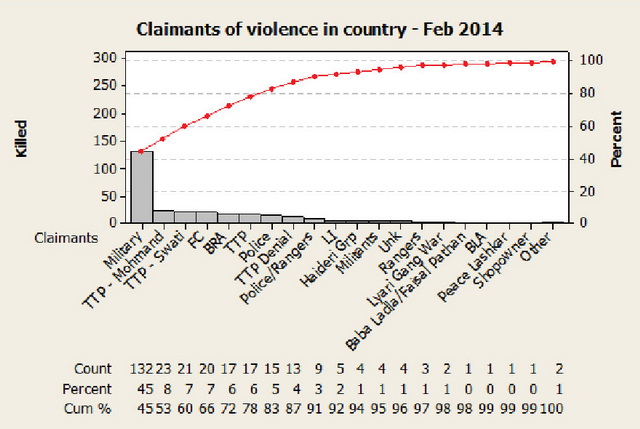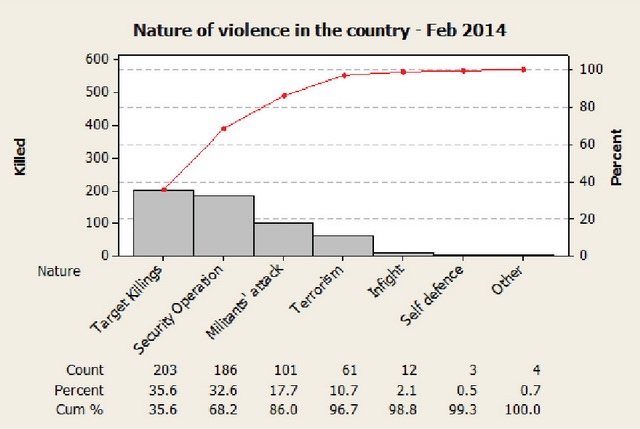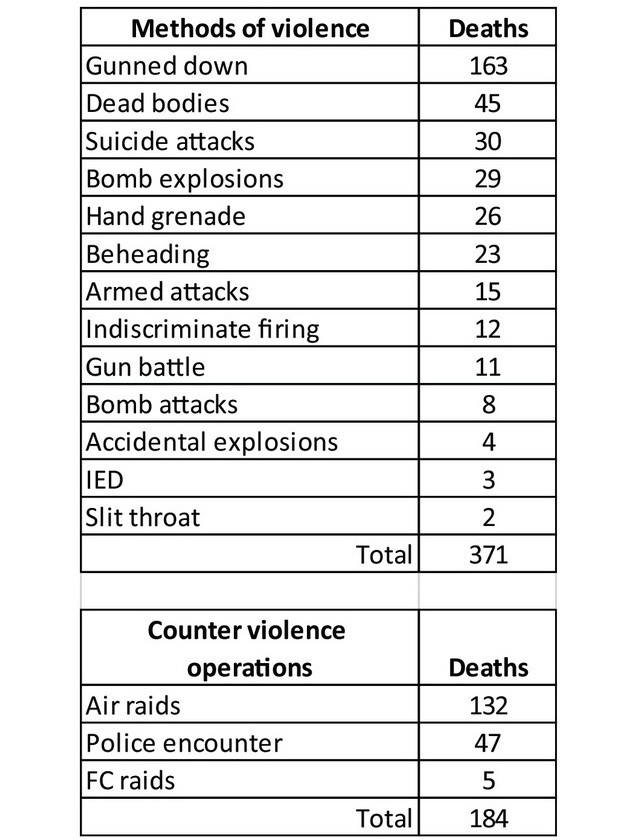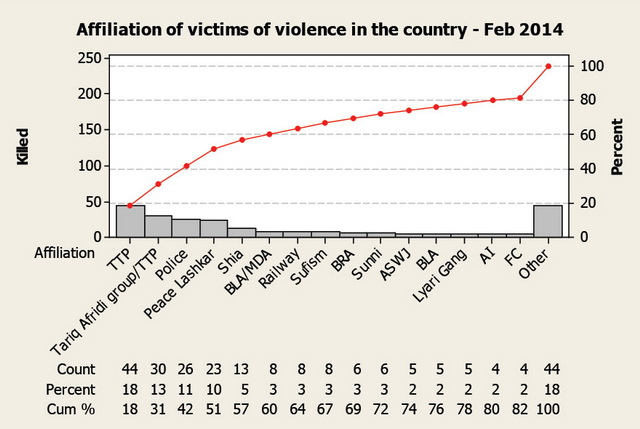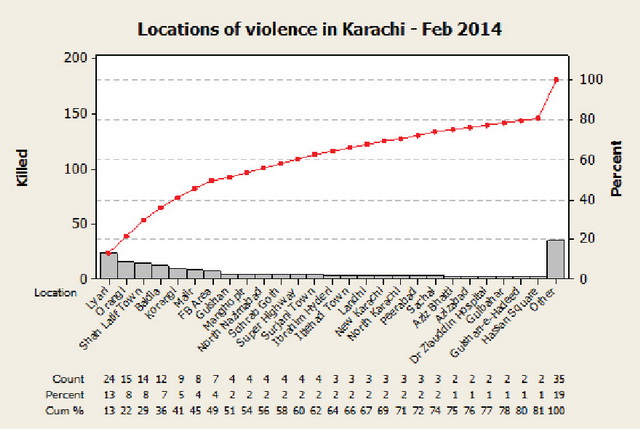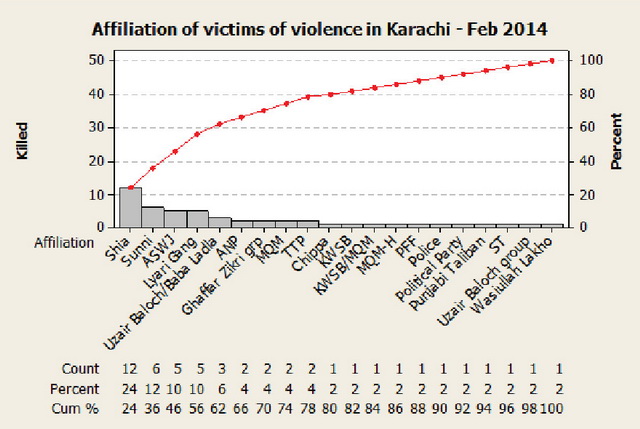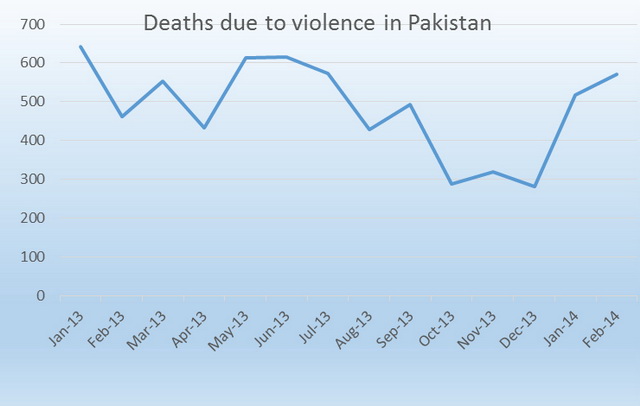The upsurge in violence noticed last month continued on and left 571 persons dead during the month of February 2014, an increase of nearly 10% in death rate compared to last month figure and 20% rise when compared with the figure of February 2013. To grapple with the violent situation the government continued swinging between peace talk and military operation until the brutal killing of 23 FC men by the militants left no reason for the government to continue with its policy of negotiation. The ongoing negotiations were put on hold and the military was given a go ahead for a retaliatory operation resulting in escalation of the number of deaths due to security operation.
The ongoing targeted operation in Karachi came under severe criticism this month from political parties as well as from the news media. However, it couldn–t desist the resolve of the Sindh government to continue with the operation. Conforming to the order of the Supreme Court, the Additional Inspector General, Shahid Hayat, submitted a report claiming 50% decline in target killings in Karachi from September last year.
This was the second month in a row that no violation of Pakistani territory was committed by the infamous drones. Yet, the militancy continued taking its toll and no respite seemed predictable for the near future.
All these events and other facts reported in the national newspapers are collected to make this report as informative and factual as possible. Errors and omissions, as always a possibility in all statistical works including this one, are expected. However, such mistakes do not grossly affect the basic objective of this report. This report analyzes the overall impact of the ongoing violence in the country and shows the areas that suffered the most in terms of deaths and injuries to the people due to violence. It also reports the number of people that were claimed to have been killed by the different outlawed organizations. The religious communities that became target of sectarian violence are also covered in this report.
This report mainly covers the following topics:
Casualties of violence in the country during February 2014
Militancy and Security Operation
Militants– attacks claimed by the splinter groups of TTP
Methods of violence
Violence and Targeted operation in Karachi
Lyari gang war
Sectarian violence in Karachi
Political rivalry or ideological conflict
Growing influence of the outlawed TTP and Al-Qaeda in Karachi
CRSS will appreciate receiving comments that the readers may have on this report.
Report prepared by:
Mohammad Nafees
Senior Research Fellow
Center for Research and Security Studies
NOTE: Readers can approach CRSS for source of any information included in the report. Please send your request to: [mail@crss.pk]
OVERVIEW
Casualties of violence in the country during February 2014:
The casualties of violence during the month of February were 861 (571 dead and 360 injured) nearly 10% increase in death count from last month level (Refer to graph 1). Among all provinces, Sindh had the highest death rate while the Punjab had the lowest one (Refer to graph 2) In Sindh, Karachi alone suffered the heaviest loss of lives, 180 out of 194, North Waziristan in FATA , 107 out of 175, and in KP, Peshawar had the highest loss of human lives, 60 out of 124, (Refer to graph 3). After civilians, the militants were the next who suffered the highest losses of their activists during the month of February because of military operation. The government officials (including soldiers, policemen, Frontier Constabulary personnel, and Levies) were the third highest victims of violence during the month under review (Refer to graph 4).
Graph 1: Number of people killed due to violence Jan 2013 ´ Feb 2014:
Graph 2: Number of people killed in provinces due to violence:
Graph 3: Number of persons killed in cities:
Graph 4: Nature of violence in Pakistan ´ Feb 2014
Militancy and Security Operation:
In the month of February, militancy inflicted death to nearly 365 persons in the country in the form of target killings, militants– attacks, and terrorism. There were 39 minor and major militants– attacks leaving 101 persons dead and 196 injured, 72 incidents of terrorism causing deaths to 61 persons and injuries to 121, and 158 incidents of target killings that left 203 persons dead and 33 wounded. There were two major militants– attacks that were earlier denied by the Tehreek-e-Taliban of Pakistan (TTP) but later admitted by other splinter groups of the TTP exposing the differences existed among the different groups of TTP. In short, TTP and their splinter groups claimed to have carried out different militants– attacks in the country leaving 61 dead and 113 injured during this month (Refer to graph 5).
Graph 5: Claimants of violence in February 2014:
Militants– attacks claimed by the splinter groups of TTP:
February 05, 2014: PESHAWAR: At least nine persons were killed and 50 others, including nine women and five children, were wounded in a suicide bombing in a hotel in the narrow Koocha Risaldar street located near the historic Qissa Khwani Bazaar here on Tuesday. Agencies add: The Tehreek-e-Taliban Pakistan (TTP) condemned the blast in Peshawar[1]. Later, the splinter group of TTP led by ‘Major’ Mast Gul (TTP-Swati) claimed responsibility of this attack[2].
February 12, 2014 PESHAWAR: Thirteen persons were killed and over 24 others sustained injuries in three back-to-back blasts in the Shama Cinema on the Pajaggi Road here on Tuesday. The Pakistan Tehrik-e-Insaf (PTI) chief Imran Khan said he was grieved over the loss of lives in the condemnable blasts that are part of violence aimed at disrupting the peace process. The outlawed Tehrik-e-Taliban Pakistan (TTP), in a call to reporters in Kohat, categorically denied involvement in the attack, saying their organisation had nothing to do with it[3].
February 17, 2014 RAWALPINDI: As many as 23 FC men held by the Taliban in captivity were beheaded, the Tehrik-e-Taliban Pakistan (TTP) Mohmand Agency chapter claimed on Sunday night, Geo News reported. Khorasani claimed the Taliban had been asking the government to stop the alleged killing of their colleagues as the release of prisoners was their basic demand but the government did not listen to them. He said the FC men were killed in revenge for the alleged killing of their colleagues by the government[4].
February 24, 2014 KOHAT/BARA: Twelve persons were killed and 16 others injured in a bomb explosion triggered by a remote-control device here on Sunday, police and hospital sources said[5]. A militant group headed by ¿Major– Mast Gul claimed responsibility for Sunday bomb explosion in Kohat in which 12 people were killed and 16 injured[6].
The beheading of 23 FC men by the militants shocked the whole nation and forced the government to suspend the ongoing negotiation with the Taliban and resort to the retaliatory military operation against the Taliban. The PAF jet-fighters and the Pakistan Army gunship helicopters carried out raids on suspected hideouts of the militants in North Waziristan, Bara in Khyber Agency and in the Thall area of the Hangu district. Jet-fighters bombarded the positions of the Tehrik-e-Taliban Pakistan (TTP) in Dwatoi and Woche Waney areas of Tirah valley. Six hideouts of the TTP, including a bomb-making factory, were also destroyed in the bombardment. The local sources revealed that the warplanes also dropped a bomb near the bunker of the outlawed, Mangal Bagh-led Lashkar-e-Islam militant group in Ghaibi Neka area of the Tirah valley, but no casualty was reported in the attack. The sources said two jet-fighters bombarded the positions of the Tehrik-e-Taliban Pakistan (TTP) in Dwatoi and Woche Waney areas of Tirah valley early Sunday[7].
For the first time the Pakistan military conducted shelling in the settled area of Khyber-Pakhtunkhwa as well. On 28 February the gunship helicopters carried out air raids in tehsil Kulachi of FR Dera Ismail Khan in which three suspected militants were killed[8].
The counter violence security operations carried out by the different security agencies in the country left 186 persons dead while the victims of target killings, militants– attacks, and terrorism were 365 persons (Refer to graph 6).
Graph 6: Nature of violence in Februay 2014:
Methods of violence:
During February 2014, the following methods of violence were used by the militants and criminals to unleash their terror in the country. To counter these crimes, the security forces carried out targeted operation using air attacks, gunship helicopters, and search operations in affected areas (Refer to table 1). The data on affiliation of the victims of militancy and security operation shows that TTP and its another group TTP-Tariq Afridi Group suffered the highest losses during this month, followed by Police, Peace Lashkar, Shia community members, BLA/MDA (Baloch Liberation Front/Baloch Musala Difa Army) etc., (Refer to graph 7).
Table 1: Methods of violence and counter violence ´ February 2014
Graph 7: Affiliation of victims of violence in Februay 2014:
Violence and Targeted operation in Karachi:
Karachi lost 180 persons in violence during the month of February and the number of wounded person was 114, an increase of 10% in crime rate compared to last month fatalities of 163 persons. The victims of violence were civilians (102), criminals (28), security officials (19), militants (8), politicians (8), and religious persons (6). Police lost their 17 personnel while the Rangers lost one person. Lyari, Orangi, Shah Latif Town, Baldia, Korangi, and Malir were the localities where violence took more lives than any other place in the city (Refer to graph 8). Target killings (70%), sectarian violence (15%), and militants– attacks (13%) were the most common methods of violence in Karachi. There are several reasons for the ongoing killings in Karachi and the most significant of them are discussed below.
Graph 8: Locations of violence in Karachi Februay 2014:
Lyari gang war:
Turf war among the different gangs in Lyari, the attacks of the militants on security personnel, and the target killings on political and sectarian grounds were the main causes of killings in commercial hub of the country. Uzair Baloch group, Baba Ladla group, Ghaffar Zikri group, Wasiullah Lakho group and Faisal Pathan group are the most active Lyari gangsters fighting with each other to settle their enmities and to protect or expand their areas of influence that lead to deaths of their activists and supporters on daily basis. The inflight among the different gangsters and the ongoing targeted operation in Lyari are causing lots of hardship for the common people as a number of them are getting caught in between or targeted on suspicion.
Sectarian violence in Karachi:
Sectarian conflict is also playing its role in triggering violence in Karachi. Throughout the country, sectarianism took 34 lives and 31 of them were from Karachi. Among the 31 victims of sectarianism in Karachi there were Shia 12, Sunni 11, and followers of Sufism 8 (Refer to graph 9). Sectarian violence took a very ugly shape this month when a group of militants attacked a Sufi Shrine of Meharban Ali Shah alias Jalali Baba in Baldia Town and shot dead eight innocent persons including a two year old girl. On another day, Karachi lost ten persons belonging to Shia and Sunni communities because of sectarian violence that has been deep rooted in the country. On 28 February, the first victim of sectarian violence was a Shia scholar, Allama Syed Taqi Hadi Naqvi who was targeted in North Nazimabad. It caused retaliatory attacks that left three Sunni Maulana and a Qari dead beside other six persons belonging to both the sects[9].
Graph 9: Affiliation of victims of violence in Karachi Februay 2014:
Growing influence of the outlawed TTP and Al-Qaeda in Karachi:
The outlawed Tehreek-e-Taliban of Pakistan has now begun asserting its presence in the largest commercial city of the country by resorting to its popular suicide and armed attacks. On 14 February 2014, TTP claimed to have carried out a suicide attack near a police bus killing 13 police commandos and injuring at least 47 others in Shah Latif Town. On the very next day of this incident, another suicide attack took place when a Wing Commander of Ghazi Rangers along with security personnel was on way to Defence and was passing through Qayyumabad area. Luckily, nobody died in this incident with the exception of two Rangers who got injured[10].
Only a few days before this incident a Sufi shrine in Baldia Town was attacked by ten unidentified militants leaving eight pilgrims of the shrine dead and 11 injured. TTP didn–t claim to have carried out this attack though their past history reveals their involvements in similar attacks on other Sufi shrines at other places in the country. Within a month, their militancy left nearly 80 dead and injured in the city spreading a fear among the people and law enforcement agencies of what level of terror is awaiting them if their presence and influence in the city is ever challenged.
Even the outlawed organization Al-Qaeda is found growing its influence in this city. On 14 February 2014, the CID police arrested three suspects having links with Al-Qaeda from Karachi University and claimed to have recovered four pistols, four hand grenade, explosive material and more than 30 detonators were recovered from their custody. According to the police, the suspects were students of Karachi University and they were suspected having involvement in killing of policemen and people of Bohri community in the city. Another startling revelation made by the police was that Al-Qaeda network is present in the KU that includes professors[11].
On the same day, the Anti-Extremism Cell (AEC) of the CID police claimed to have found a major bomb-making factory of the banned Tehreek-e-Taliban Pakistan in Orangi Town. A large quantity of explosives, bomb-making material, improvised explosive devices (IEDs) and weapons were seized in the raid. While no arrests were made in the raid, experts found concrete evidence that the IEDs and bombs used in recent terror attacks in the city, including the fatal attack on Chaudhry Aslam and other law enforcers, were prepared at the factory[12].
Conclusion:
On national level, the country is divided on how to deal with the militants ´ through peace talks or war. From what was earlier blamed on the foreign hands against the peace initiative in the country has now turned into the handiwork of the splinter groups of the Taliban that appear to have been sabotaging such efforts if we believe what the Taliban and their supporters claim. The government is still showing its sincerity in holding peace talks with the Taliban and avoid any bloodbath that may result from a military operation against the militants. However, the question is; ‘how effectively the Taliban can manage their splinter groups to follow the commitments they make with the government?’ Once they guarantee such an adherence by the majority of the militants, the next challenge would be to explore a common point of negotiation where militancy and intolerance have no or little influence.
In Karachi, with the rise in crime rate during last two month, the positive results of the targeted operation seem to have begun diminishing now. Although, police department claims to have been able to bring 50% reduction in target killing victims from September last year, our data shows a different trend (Refer to graph 10).
Graph 10: Deaths due to target killings in Karachi August 2013 – February 2014:
The government and security agencies have to take extra measures to improve law and order situation in the city and to ensure that the new entrants in the volatile situation of Karachi (like TTP, AQ, and other militant groups) may not get so strong that they become highly uncontrollable.

